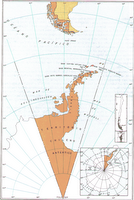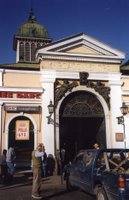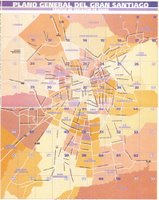
The New York Times has an article in today’s paper (actually, tomorrow’s) about traveling to Easter Island, which belongs to Chile. I found the piece rather steeped in the author’s own personal journey: I am glad it is good for you and that you found peace there. Good for you. I thought it was a bit too mystical for my own tastes, but I’ll readily admit that my knowledge of Easter Island comes from random guide books and a Chilean teleserie, Iorana, that is set on Rapa Nui.
 I tend to forget that it is a Chilean possession except for when Iorana is on or I see the television weather broadcast. There is much to be said for staking out national territory through the weather broadcast; on Chilean TV, you get weather for all the regions of the mainland, plus Rapa Nui, Islas Juan Fernandez, and Antarctica.
I tend to forget that it is a Chilean possession except for when Iorana is on or I see the television weather broadcast. There is much to be said for staking out national territory through the weather broadcast; on Chilean TV, you get weather for all the regions of the mainland, plus Rapa Nui, Islas Juan Fernandez, and Antarctica.The author of this particular piece, however, mentions that a traveler to Rapa Nui must go through Santiago to get there. So does everyone else who talks about traveling to Rapa Nui, for the most part. Most people leave it at that. However, this travel writer regales the reader with his own perception of Santiago. I quote:
Since you'll be spending a day in Santiago both before and after your visit to Easter Island, there are a few things you should experience there. There is the extraordinary Pre-Colombian Museum in the center of town with quite amazing pieces from the various cultures from Central Mexico right down to Patagonia. And not far from this museum is the wonderful Central Market, a great wrought-iron structure having in it huge fish markets as well as seafood restaurants. If you have never experienced the tiny nail-size baby eels sautéed in olive oil and garlic (which I first enjoyed in Madrid) just forget you're eating eel and have a wonderful meal. Santiago itself is a little grubby but what else would you expect after nearly 20 years of military dictatorship, fortunately now ended. The Santiago Crown Plaza Hotel is central and quite comfortable.
 Thank you so much for telling us about your version of Santiago. I’ve never managed to get to the Museo Chileno de Arte Precolombino, but one day I will. And then I will report back. Everyone is obsessed with the Mercado Central – except for people like me who don’t eat seafood. That sort of gets in the way. By the way, thank you for couching all your references to Santiago in terms of your visits to other places – is the Museo extraordinary because it features things from outside Chile? We must, of course, know that you first tried the baby eels in Madrid. Look how well traveled you are.
Thank you so much for telling us about your version of Santiago. I’ve never managed to get to the Museo Chileno de Arte Precolombino, but one day I will. And then I will report back. Everyone is obsessed with the Mercado Central – except for people like me who don’t eat seafood. That sort of gets in the way. By the way, thank you for couching all your references to Santiago in terms of your visits to other places – is the Museo extraordinary because it features things from outside Chile? We must, of course, know that you first tried the baby eels in Madrid. Look how well traveled you are.“Santiago itself is a little grubby”: What other part of Santiago were you referring to in the rest of the paragraph? For someone who makes such a big deal about boning up on the place you are going to visit, he definitely didn’t do too much research into Santiago. I’ll admit that my cuñada refers to Santiago as Santiasco and that there are parts that are prettier than others, but for a city of 6 million, it’s not too bad. People smoke all over the place, there are stray dogs that people are quite fond of, there are people selling things on the street. Depending on the time of year, it can be a bit dusty or smoggy. But grubby, I would not use to describe an entire city. Not only is this author betraying his woefully limited knowledge of the city, he is also reducing an extensive area to one adjective that, in my opinion, doesn’t describe it. “Grubby.” I might say smoggy, dusty, in some areas dirty, but grubby, to me, implies decay and a lack of interest in maintenance.
 The best part, for me, is that this writer has to link his perception of Santiago as “grubby” (which I disagree with) with the dictatorship. How well you know your history! Yes, Chile had 17 years of dictatorship. It has also had 17 years of democracy since the fall of the dictatorship. In fact, Chile had elections this year and - guess what?! A woman is President. Did this author see the ghostly stains of past events grubbing up the city? Yes, the dictatorship was horrible, something that anyone who knows me has probably heard a lot about. But Chile is very different now. Santiago has changed a lot even in the past 3 years. His linkage of his view of Santiago as “grubby,” already problematic, becomes even odder in his explanation of his perceptions.
The best part, for me, is that this writer has to link his perception of Santiago as “grubby” (which I disagree with) with the dictatorship. How well you know your history! Yes, Chile had 17 years of dictatorship. It has also had 17 years of democracy since the fall of the dictatorship. In fact, Chile had elections this year and - guess what?! A woman is President. Did this author see the ghostly stains of past events grubbing up the city? Yes, the dictatorship was horrible, something that anyone who knows me has probably heard a lot about. But Chile is very different now. Santiago has changed a lot even in the past 3 years. His linkage of his view of Santiago as “grubby,” already problematic, becomes even odder in his explanation of his perceptions. In short: Way to disparage a city without really getting to know it and unnecessarily simplifying its history! Congratulations!
Perhaps I am being too harsh. However, for an article supposedly about Rapa Nui, the attacks on a city that’s really not that bad are, in my opinion, unwarranted.























